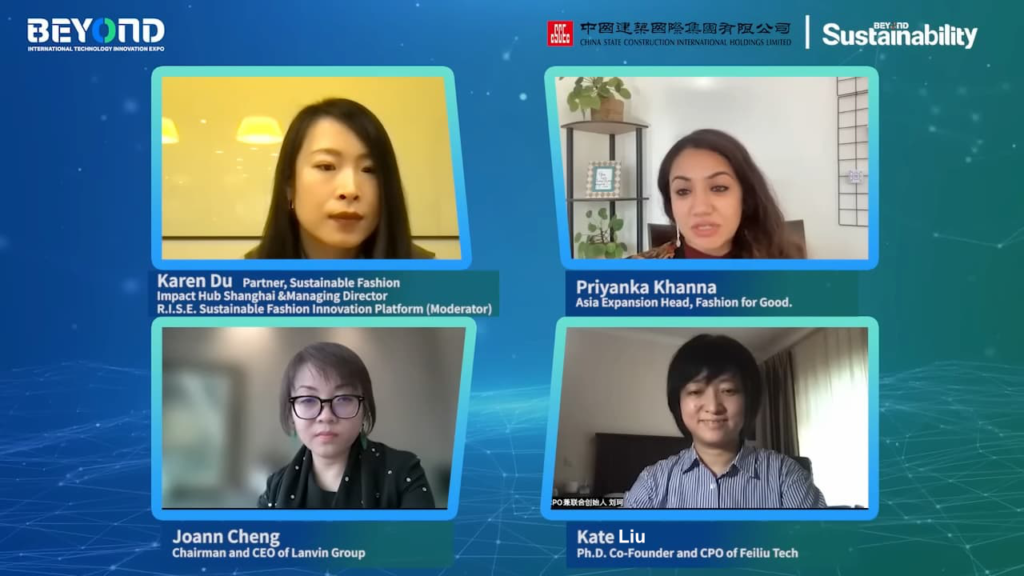An intrinsic part of most people’s daily lives, the fashion industry also consumes a huge amount of resources. The industry is the second highest polluting industry, after petroleum. One cotton shirt usually requires 700 gallons of water to be produced, an amount sufficient for one person to drink for 3.5 years, according to Joann Cheng, Chairman and CEO of luxury fashion firm Lanvin Group.
To improve sustainability in the industry, efforts are needed at all levels – from supply chains to sale channels – and the importance of new business models can also help the transition.
Representatives from Lanvin Group, Fashion for Good, and Feiliu Tech shared insights on sustainability in the fashion industry and the approaches required to improve it at the BEYOND Expo 2022 sustainability conference, held online in the BEYOND Metaverse.
The text below features some of the highlights of the discussion and has been condensed and edited for clarity.

Joann Cheng, chairman and CEO of Lanvin Group
Sustainability is not just about fabric or some technology but about the supply chain.
When we talk about the supply chain, everybody talks about how to minimize costs to improve efficiency. But sustainability is not about reducing the cost. The key is to protect our environment and to get long-term protection. So we must think about new business models and challenge the old way of saving dollars by including more fashion pieces.
I think we have to change our current business model from the supply chain to the sales channel to get sustainability to the next level.
We challenge ourselves in an innovative way in how we sell. For example, there are a lot of platforms in the market now focusing on resales, repairs, or rentals. And some fashion pieces can be recycled. There are a lot of brands, like Allbirds, using a very sustainable fabric as a fundamental of the product. However, this is definitely a trade-off of profitability versus sustainability because getting there costs more money.
We also linked the design and the product to the sustainability concept. For example, Wolford is a brand in our group. It is the first to achieve the gold level of accreditation from Cradle to Cradle in this industry. This means our products are 100% disposable.
And we have designed a special capsule: Aurora uses a fabric that is totally not polluting to the environment and really 100% disposable. By pushing them to the market customers, we can really contribute our efforts to sustainability.
There still is a long road to go, but we have a long-term vision on ESG and sustainability and will take action going forward.
Priyanka Khanna, Asia Expansion Head, Fashion for Good
In my opinion, the industry dynamics need to change quite a lot. This buyer-seller relationship exists in the industry between the brand and the supplier. That dynamic needs to be changed into [something] more co-developed and co-created. And literally bringing on board with these suppliers and brands the technologies that would make this change happen.
We foresee that to transform this industry, to make it more circular and sustainable, you have to infuse technology into it. We are hoping to find these technologies, assessing whether they can actually work with a larger industry or industry as a whole, and we then support these technologies to scale with the existing players and hopefully with industry-wide integration in the future.
It’s multiple industries in the one fashion industry. It’s so large and so complicated in each supply chain step, from raw materials to processing, to actual manufacturing, and all the way to the end of use. There are multiple technology intervention areas that can potentially transform the industry’s footprint, reducing the usage of natural resources like water and overall carbon emissions, the pollution of water, etcetera.
To make that happen, we work with multiple [parties]. I think one of the most important is the manufacturers. They have to be brought on board and educated on everything happening because they are usually the final people to work with the innovations. Now we’ve looked at about 3,000 technologies, and we’re working with about 157 across the supply chain. We have brands supporting this initiative, partnering to assess which technologies can work and then supporting scaling them.
Kate Liu, Ph.D. Co-Founder and CPO of Feiliu Tech
In our opinion, most of the fashion industry’s impact is not only at the ground level but also at the production level at the supply chain side. It’s about the raw materials and the whole production process.
We are trying to bring a new concept of sustainable fashion into this very traditional area, especially the manufacturing side. When we talk about the supply chain issue, we talk about the factories and the workers in the [production] lines. They do a lot of work, such as sewing and cutting, for the process. And they usually need some technology to help them improve efficiency while doing all the processes.
Big orders with large quantities usually give you enough time to get familiar with procedures to make their work more effective. But for small companies and orders with a very short delivery time, you need a delicate plan to make a dynamic production process.
On the supply chain side, with AI’s help, the factory can have a brain to make decisions, so it’s not only on the technical person, the plant owner, or the team leader. It can also have all the data and collect the digitalization process from each station and each worker. Then AI can also analyze to make the workers more effective.
In this way, people can take small orders in small quantities. This flexible work can avoid overproduction and waste in the fashion industry, making the whole thing more sustainable.